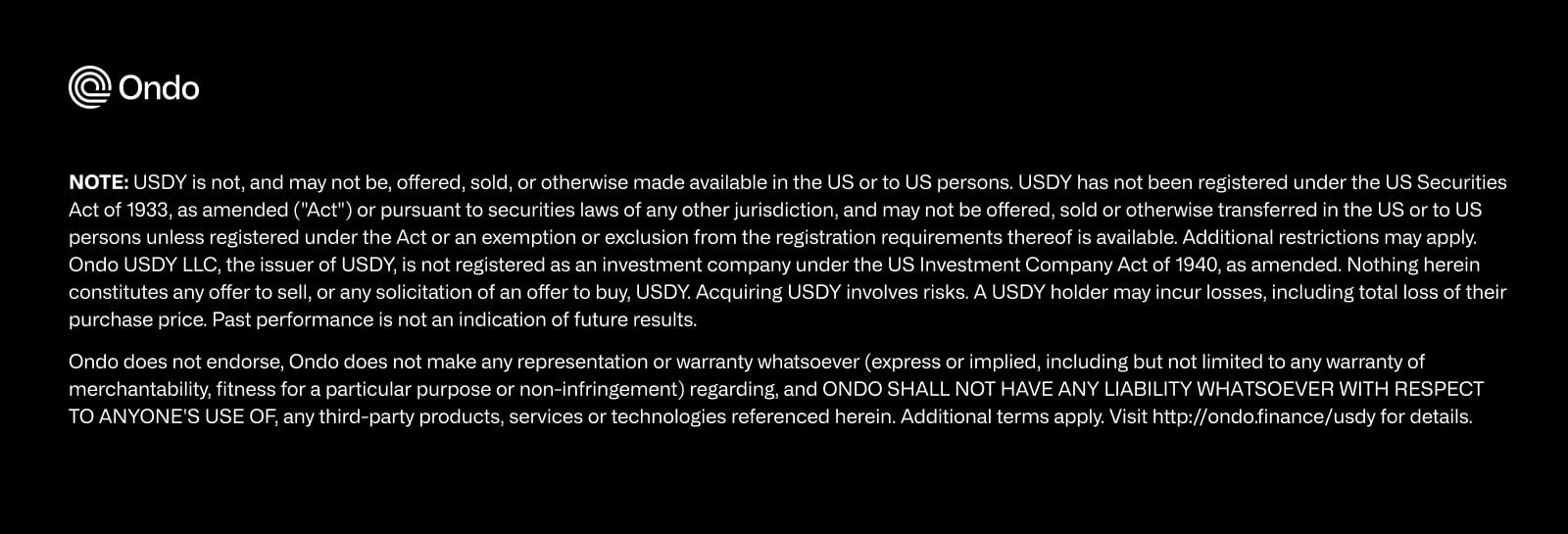BounceBit Integrates USDY as First Tokenized RWA on CeDeFi V2


CeDeFi V2 Platform Will Provide Seamless RWA Exposure via the USDY Vault
BounceBit’s innovative CeDeFi V2 platform is going live with full support for a standalone USDY Vault, making access to USDY’s US Treasury yield easier than ever within its ecosystem. This marks a significant unlock in expanding real-world asset (RWA) access with a simple, easy-to-understand interface, creating new opportunities for users to tap into tokenized US treasuries products within CeDeFi.
BounceBit’s CeDeFi is a hybrid financial model that combines the advantages of centralized finance (user-friendly interfaces, regulatory compliance prioritization) with the innovations of DeFi (smart contracts, tokenized assets), and aims to bridge TradFi and DeFi within a secure, regulated ecosystem.
CeDeFi V2: One-Click Yieldcoin Returns + Rewards
CeDeFi V2 is a significant product line expansion over BounceBit’s CeDeFi V1, which was successful in establishing the CeDeFi interface. BounceBit CeDeFi V2 is now chain-agnostic and introduces various bluechip assets as eligible assets for “real” yield generated via delta-neutral strategies. As the first US Treasury-backed asset on the V2 platform, USDY’s integration paves the way for a new dimension of yieldcoin unlocks. Users can now easily deploy USDY in a dedicated vault on BounceBit, without needing to lock up tokens, and benefit from the platform’s boosted $BB token incentives. This initiative mirrors BounceBit’s successful collaboration with Ethena earlier this year, further strengthening its position as a leading CeDeFi innovator.
Expanding Real-World Assets in CeDeFi
BounceBit’s integration of Ondo’s tokenized US Treasuries products is a step that is aligned with our mission to bring the utility of RWAs to anyone, anywhere, via DeFi, while still maintaining broad customer protections. USDY on BounceBit creates a simple, one-click yield-bearing opportunity, driving wider adoption of tokenized RWAs. BounceBit is pioneering the convergence of traditional and decentralized finance with their CeDeFi model, and by offering US Treasury-backed assets like USDY, it has never been easier for anyone to tap into previously privileged financial products.

Tapping Into the USDY Vault on BounceBit
Users can now access the USDY CeDeFi vault through BounceBit's dedicated interface and start earning yields in three simple steps:
- Visit the USDY vault in the RWA tab at app.bouncebit.io/vaults/usdy
- Connect your wallet
- Deploy your assets and start earning
The integration in the BounceBit Platform is the first opportunity to tap into USDY via CeDeFi infrastructure, making yield opportunities as simple as any one-click retail finance application. BounceBit provides this infrastructure via the BounceBit chain, a dual-token PoS Layer 1 secured by BTC and $BB, which leverages Bitcoin's security with full EVM compatibility. USDY exposure on the platform will be via Ethereum-native USDY.
Recap on USDY
USDY is the world’s first tokenized note secured by short-term US Treasuries in a bankruptcy-remote special purpose vehicle. It is accessible to non-US individual and institutional investors and is designed to combine the accessibility of stablecoins with high-quality, US dollar-denominated yield. Key features include:
- Broad Accessibility: Tokenized loan that can trade globally in secondary markets to non-US investors
- Yield: Accrues a variable interest rate, adjusted monthly by the issuer. Yield accrues in the form of a redemption value that increases over time
- Daily Liquidity: Non-US investors can both mint and redeem USDY on a daily basis
- High-Quality Collateral: Secured by short-term US Treasuries under control agreements
- Regulatory Compliance Focus: Offered and sold in a continuous Regulation S offering to non-US investors; issuer has a money services business registration with the US Treasury’s Financial Crimes Enforcement Network
- Bankruptcy-Remoteness: Assets designed to be ring-fenced from a hypothetical Ondo bankruptcy

